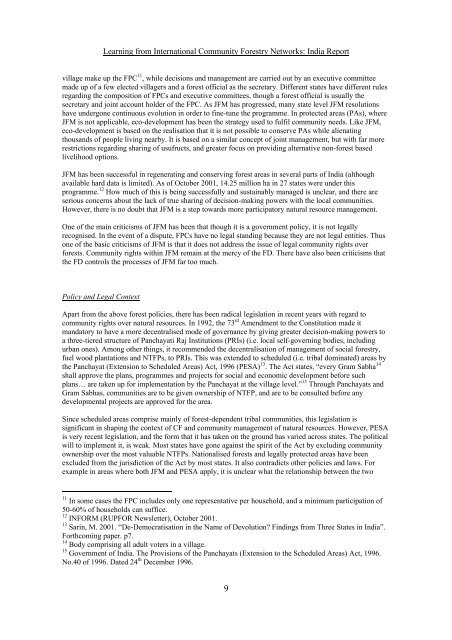Snapshots of International Community Forestry Networks: Country ...
Snapshots of International Community Forestry Networks: Country ...
Snapshots of International Community Forestry Networks: Country ...
Create successful ePaper yourself
Turn your PDF publications into a flip-book with our unique Google optimized e-Paper software.
Learning from <strong>International</strong> <strong>Community</strong> <strong>Forestry</strong> <strong>Networks</strong>: India Report<br />
village make up the FPC 11 , while decisions and management are carried out by an executive committee<br />
made up <strong>of</strong> a few elected villagers and a forest <strong>of</strong>ficial as the secretary. Different states have different rules<br />
regarding the composition <strong>of</strong> FPCs and executive committees, though a forest <strong>of</strong>ficial is usually the<br />
secretary and joint account holder <strong>of</strong> the FPC. As JFM has progressed, many state level JFM resolutions<br />
have undergone continuous evolution in order to fine-tune the programme. In protected areas (PAs), where<br />
JFM is not applicable, eco-development has been the strategy used to fulfil community needs. Like JFM,<br />
eco-development is based on the realisation that it is not possible to conserve PAs while alienating<br />
thousands <strong>of</strong> people living nearby. It is based on a similar concept <strong>of</strong> joint management, but with far more<br />
restrictions regarding sharing <strong>of</strong> usufructs, and greater focus on providing alternative non-forest based<br />
livelihood options.<br />
JFM has been successful in regenerating and conserving forest areas in several parts <strong>of</strong> India (although<br />
available hard data is limited). As <strong>of</strong> October 2001, 14.25 million ha in 27 states were under this<br />
programme. 12 How much <strong>of</strong> this is being successfully and sustainably managed is unclear, and there are<br />
serious concerns about the lack <strong>of</strong> true sharing <strong>of</strong> decision-making powers with the local communities.<br />
However, there is no doubt that JFM is a step towards more participatory natural resource management.<br />
One <strong>of</strong> the main criticisms <strong>of</strong> JFM has been that though it is a government policy, it is not legally<br />
recognised. In the event <strong>of</strong> a dispute, FPCs have no legal standing because they are not legal entities. Thus<br />
one <strong>of</strong> the basic criticisms <strong>of</strong> JFM is that it does not address the issue <strong>of</strong> legal community rights over<br />
forests. <strong>Community</strong> rights within JFM remain at the mercy <strong>of</strong> the FD. There have also been criticisms that<br />
the FD controls the processes <strong>of</strong> JFM far too much.<br />
Policy and Legal Context<br />
Apart from the above forest policies, there has been radical legislation in recent years with regard to<br />
community rights over natural resources. In 1992, the 73 rd Amendment to the Constitution made it<br />
mandatory to have a more decentralised mode <strong>of</strong> governance by giving greater decision-making powers to<br />
a three-tiered structure <strong>of</strong> Panchayati Raj Institutions (PRIs) (i.e. local self-governing bodies, including<br />
urban ones). Among other things, it recommended the decentralisation <strong>of</strong> management <strong>of</strong> social forestry,<br />
fuel wood plantations and NTFPs, to PRIs. This was extended to scheduled (i.e. tribal dominated) areas by<br />
the Panchayat (Extension to Scheduled Areas) Act, 1996 (PESA) 13 . The Act states, “every Gram Sabha 14<br />
shall approve the plans, programmes and projects for social and economic development before such<br />
plans… are taken up for implementation by the Panchayat at the village level.” 15 Through Panchayats and<br />
Gram Sabhas, communities are to be given ownership <strong>of</strong> NTFP, and are to be consulted before any<br />
developmental projects are approved for the area.<br />
Since scheduled areas comprise mainly <strong>of</strong> forest-dependent tribal communities, this legislation is<br />
significant in shaping the context <strong>of</strong> CF and community management <strong>of</strong> natural resources. However, PESA<br />
is very recent legislation, and the form that it has taken on the ground has varied across states. The political<br />
will to implement it, is weak. Most states have gone against the spirit <strong>of</strong> the Act by excluding community<br />
ownership over the most valuable NTFPs. Nationalised forests and legally protected areas have been<br />
excluded from the jurisdiction <strong>of</strong> the Act by most states. It also contradicts other policies and laws. For<br />
example in areas where both JFM and PESA apply, it is unclear what the relationship between the two<br />
11<br />
In some cases the FPC includes only one representative per household, and a minimum participation <strong>of</strong><br />
50-60% <strong>of</strong> households can suffice.<br />
12<br />
INFORM (RUPFOR Newsletter), October 2001.<br />
13<br />
Sarin, M. 2001. “De-Democratisation in the Name <strong>of</strong> Devolution? Findings from Three States in India”.<br />
Forthcoming paper. p7.<br />
14<br />
Body comprising all adult voters in a village.<br />
15<br />
Government <strong>of</strong> India. The Provisions <strong>of</strong> the Panchayats (Extension to the Scheduled Areas) Act, 1996.<br />
No.40 <strong>of</strong> 1996. Dated 24 th December 1996.<br />
9

















![CynefinFramework final [Read-Only]](https://img.yumpu.com/19017304/1/190x135/cynefinframework-final-read-only.jpg?quality=85)